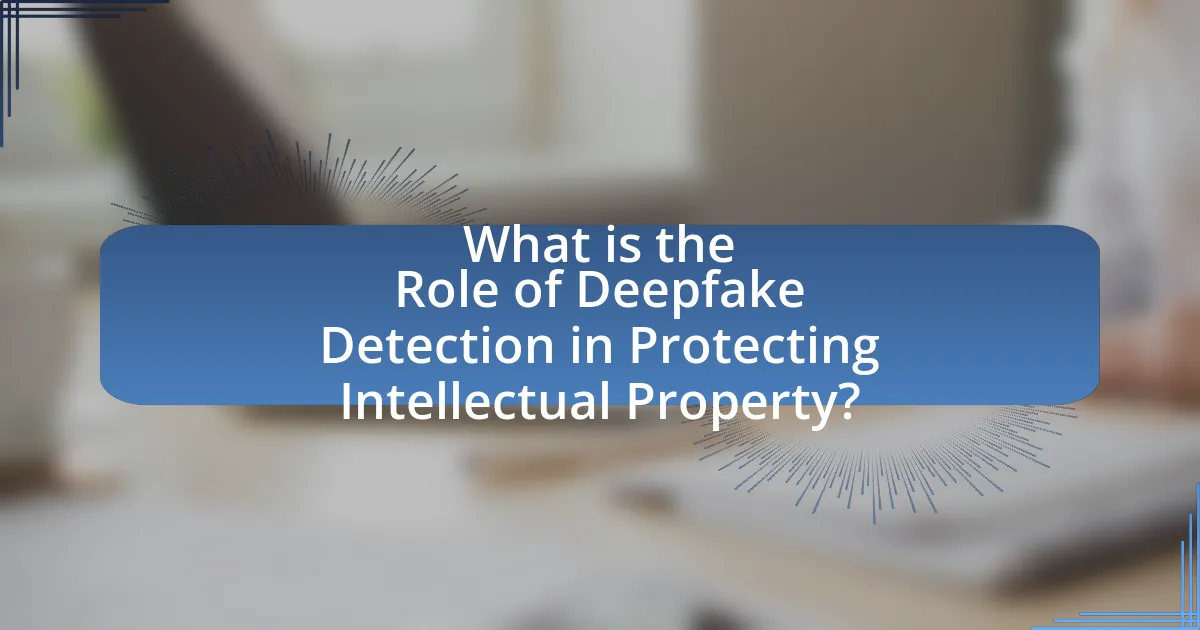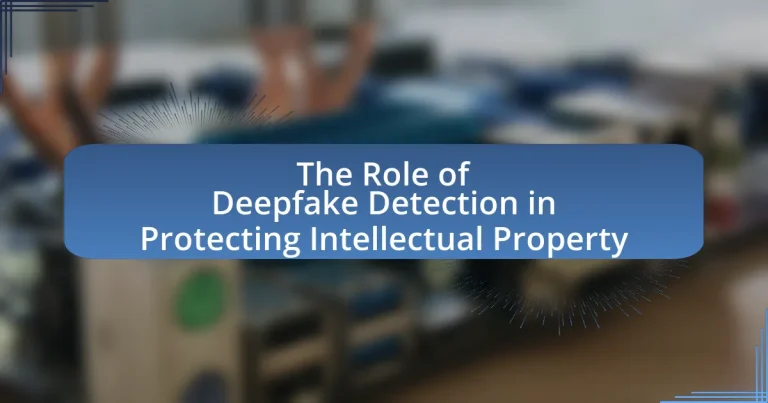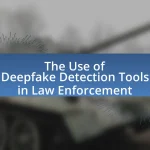Deepfake detection is essential for protecting intellectual property by identifying and mitigating risks associated with manipulated media that can infringe on copyrights and trademarks. The article explores how deepfake technology threatens intellectual property through the unauthorized creation of realistic but fabricated content, leading to financial losses and reputational damage for brands. It discusses various types of deepfakes, detection methods such as machine learning algorithms and digital forensics, and the implications for intellectual property rights. Additionally, the article highlights best practices for businesses to implement effective deepfake detection strategies and the importance of collaboration with cybersecurity experts to safeguard original works in an increasingly digital landscape.

What is the Role of Deepfake Detection in Protecting Intellectual Property?
Deepfake detection plays a crucial role in protecting intellectual property by identifying and mitigating the risks associated with manipulated media that can infringe on copyrights and trademarks. The technology enables the detection of altered images, videos, and audio, which can be used to misrepresent original works or create counterfeit content. For instance, a study published in the journal “Nature” highlights that deepfake technology can be exploited to create unauthorized replicas of brand advertisements, leading to potential financial losses and brand reputation damage. By employing deepfake detection methods, companies can safeguard their intellectual property rights, ensuring that their original content is not misused or misrepresented in a way that could harm their business interests.
How does deepfake technology pose a threat to intellectual property?
Deepfake technology poses a threat to intellectual property by enabling the unauthorized creation and distribution of realistic but fabricated content that can misrepresent individuals or brands. This manipulation can lead to significant financial losses, as companies may suffer reputational damage or face legal challenges due to the misuse of their intellectual property. For instance, deepfakes can be used to create counterfeit advertisements or misleading endorsements, undermining the authenticity of a brand’s image. According to a report by the Brookings Institution, deepfake technology has the potential to disrupt markets and erode trust in digital content, highlighting the urgent need for effective detection methods to safeguard intellectual property rights.
What are the different types of deepfakes that can infringe on intellectual property?
Different types of deepfakes that can infringe on intellectual property include synthetic media, manipulated audio, and altered video content. Synthetic media, which involves creating realistic images or videos of individuals who did not participate in the original content, can violate rights of publicity and copyright. Manipulated audio deepfakes can misrepresent a person’s voice, leading to potential trademark infringements if used in commercial contexts. Altered video content can mislead viewers and damage the reputation of brands or individuals, constituting a breach of intellectual property rights. These forms of deepfakes pose significant risks to the integrity of original works and the rights of creators.
Why is it important to address deepfake threats in the context of intellectual property?
Addressing deepfake threats is crucial in the context of intellectual property because deepfakes can undermine the authenticity and ownership of creative works. The proliferation of deepfake technology enables the unauthorized manipulation of images, videos, and audio, which can lead to the misrepresentation of original content and the infringement of intellectual property rights. For instance, a study by the University of California, Berkeley, found that deepfakes can significantly damage brand reputation and consumer trust, leading to financial losses for creators and companies. Protecting intellectual property from deepfake threats ensures that creators maintain control over their work and that their rights are upheld in a digital landscape increasingly susceptible to manipulation.
What are the key methods of deepfake detection?
Key methods of deepfake detection include machine learning algorithms, visual artifacts analysis, and biometric verification. Machine learning algorithms, particularly convolutional neural networks, are trained to identify inconsistencies in deepfake videos by analyzing pixel-level details and patterns that differ from genuine content. Visual artifacts analysis focuses on detecting anomalies such as unnatural facial movements, inconsistent lighting, and irregular blinking patterns that are often present in deepfakes. Biometric verification utilizes unique human features, such as voice recognition and facial recognition, to authenticate identities and ensure the authenticity of the media. These methods are supported by research indicating that deepfake detection technologies can achieve high accuracy rates, with some models reaching over 90% in identifying manipulated content.
How do machine learning algorithms contribute to deepfake detection?
Machine learning algorithms significantly enhance deepfake detection by analyzing patterns and anomalies in digital content. These algorithms utilize techniques such as convolutional neural networks (CNNs) and recurrent neural networks (RNNs) to identify inconsistencies in facial movements, audio-visual synchronization, and pixel-level artifacts that are often present in manipulated media. For instance, a study published in 2020 by Korshunov and Marcel demonstrated that machine learning models could achieve over 90% accuracy in distinguishing between real and deepfake videos by training on large datasets of both types. This capability allows for the effective identification of deepfakes, thereby protecting intellectual property by preventing the unauthorized use of individuals’ likenesses and maintaining the integrity of digital content.
What role do digital forensics play in identifying deepfakes?
Digital forensics plays a crucial role in identifying deepfakes by employing advanced analytical techniques to detect inconsistencies in digital media. These techniques include examining metadata, analyzing pixel-level anomalies, and utilizing machine learning algorithms to differentiate between authentic and manipulated content. For instance, research has shown that digital forensics can reveal discrepancies in lighting, shadows, and facial movements that are often overlooked by the human eye, thereby providing concrete evidence of manipulation. This capability is essential for protecting intellectual property, as it helps to maintain the integrity of original content and prevent unauthorized use or misrepresentation.
What are the implications of deepfake detection for intellectual property rights?
Deepfake detection has significant implications for intellectual property rights by enhancing the ability to identify unauthorized use of copyrighted material. The technology allows creators to protect their original works from being manipulated or misrepresented, which is crucial in industries like film, music, and art where authenticity is paramount. For instance, the use of deepfake technology to create counterfeit versions of a celebrity’s likeness can infringe on their rights and lead to financial losses. Legal frameworks are evolving to address these challenges, as seen in cases where courts have recognized the need for robust detection methods to uphold intellectual property protections. Thus, effective deepfake detection serves as a critical tool in safeguarding the rights of creators and maintaining the integrity of intellectual property.
How can deepfake detection help in legal disputes over intellectual property?
Deepfake detection can significantly aid in legal disputes over intellectual property by providing verifiable evidence of content authenticity. In cases where deepfakes are used to infringe on copyrights or trademarks, detection technologies can identify manipulated media, thereby establishing whether the content in question is genuine or altered. For instance, a study published in the journal “Nature” demonstrated that advanced algorithms could accurately detect deepfake videos with over 90% precision, which can be crucial in court to validate claims of intellectual property theft. This capability not only helps in protecting original works but also assists in holding infringers accountable by providing concrete proof of manipulation.
What are the potential consequences of failing to detect deepfakes in intellectual property cases?
Failing to detect deepfakes in intellectual property cases can lead to significant legal and financial repercussions. Intellectual property owners may suffer from unauthorized use of their content, resulting in lost revenue and diminished brand integrity. For instance, a study by the University of Southern California found that deepfakes can undermine trust in media, leading to a decrease in consumer confidence and potential market value for affected brands. Additionally, legal disputes may arise, burdening the judicial system and increasing costs for all parties involved. The inability to identify deepfakes can also facilitate the spread of misinformation, further complicating the enforcement of intellectual property rights.
How can businesses implement deepfake detection strategies?
Businesses can implement deepfake detection strategies by integrating advanced machine learning algorithms and utilizing specialized software tools designed for identifying manipulated media. These technologies analyze video and audio content for inconsistencies, such as unnatural facial movements or audio mismatches, which are common in deepfakes. For instance, companies like Deeptrace and Sensity AI provide solutions that leverage AI to detect deepfake content effectively. Additionally, businesses should establish protocols for verifying the authenticity of media before dissemination, including cross-referencing with trusted sources and employing watermarking techniques to track original content. Implementing these strategies can significantly reduce the risk of intellectual property theft and misinformation, as evidenced by a report from the Deepfake Detection Challenge, which highlighted the effectiveness of AI in identifying deepfake videos with over 90% accuracy in controlled environments.
What tools and technologies are available for businesses to detect deepfakes?
Businesses can utilize various tools and technologies to detect deepfakes, including machine learning algorithms, digital forensics software, and blockchain technology. Machine learning algorithms, such as those developed by companies like Deeptrace and Sensity, analyze video and audio content for inconsistencies that indicate manipulation. Digital forensics software, such as Amber Video and Serelay, provides capabilities to verify the authenticity of media by examining metadata and visual artifacts. Additionally, blockchain technology can be employed to create immutable records of original content, making it easier to identify alterations. These tools are essential for businesses to safeguard their intellectual property against the risks posed by deepfakes.
How can organizations train their staff to recognize deepfake threats?
Organizations can train their staff to recognize deepfake threats by implementing comprehensive training programs that focus on identifying the characteristics of deepfakes. These programs should include workshops that educate employees about the technology behind deepfakes, such as machine learning and artificial intelligence, and how these technologies can be manipulated to create misleading content.
Additionally, organizations can utilize real-world examples of deepfake incidents to illustrate the potential risks and consequences, thereby enhancing awareness. Regular updates on the latest deepfake detection tools and techniques should also be provided, as the technology is continuously evolving.
Research indicates that training programs that incorporate interactive elements, such as quizzes and hands-on practice with detection software, significantly improve retention and recognition skills among employees. For instance, a study published in the Journal of Cybersecurity found that organizations that conducted regular training sessions saw a 40% increase in staff ability to identify deepfake content.
What best practices should be followed for effective deepfake detection?
Effective deepfake detection requires a combination of advanced technology, continuous training, and collaboration among stakeholders. Utilizing machine learning algorithms that analyze inconsistencies in facial movements, audio-visual synchronization, and pixel-level anomalies enhances detection accuracy. Research indicates that deepfake detection systems benefit from large datasets of both genuine and manipulated content, allowing models to learn distinguishing features effectively. Additionally, implementing real-time detection tools in social media platforms can help mitigate the spread of deepfakes. Collaboration between tech companies, researchers, and policymakers is essential to establish standards and share best practices, as highlighted in the 2020 report by the Partnership on AI, which emphasizes the importance of a multi-faceted approach to combat deepfake technology.
How can regular audits enhance deepfake detection efforts?
Regular audits can enhance deepfake detection efforts by systematically evaluating and improving detection algorithms and processes. These audits identify weaknesses in existing detection systems, ensuring they adapt to evolving deepfake technologies. For instance, a study by the University of California, Berkeley, demonstrated that continuous evaluation of detection models significantly improved their accuracy in identifying manipulated media. By implementing regular audits, organizations can maintain a robust defense against deepfakes, thereby protecting intellectual property more effectively.
What role does collaboration with cybersecurity experts play in deepfake detection?
Collaboration with cybersecurity experts is crucial in deepfake detection as it enhances the effectiveness of identifying and mitigating threats posed by manipulated media. Cybersecurity experts bring specialized knowledge in digital forensics, machine learning, and threat analysis, which are essential for developing advanced detection algorithms and tools. For instance, a study by the University of California, Berkeley, highlights that integrating cybersecurity methodologies significantly improves the accuracy of deepfake detection systems, reducing false positives and enhancing reliability. This collaboration ensures that organizations can better protect their intellectual property from the risks associated with deepfakes, such as misinformation and brand damage.

